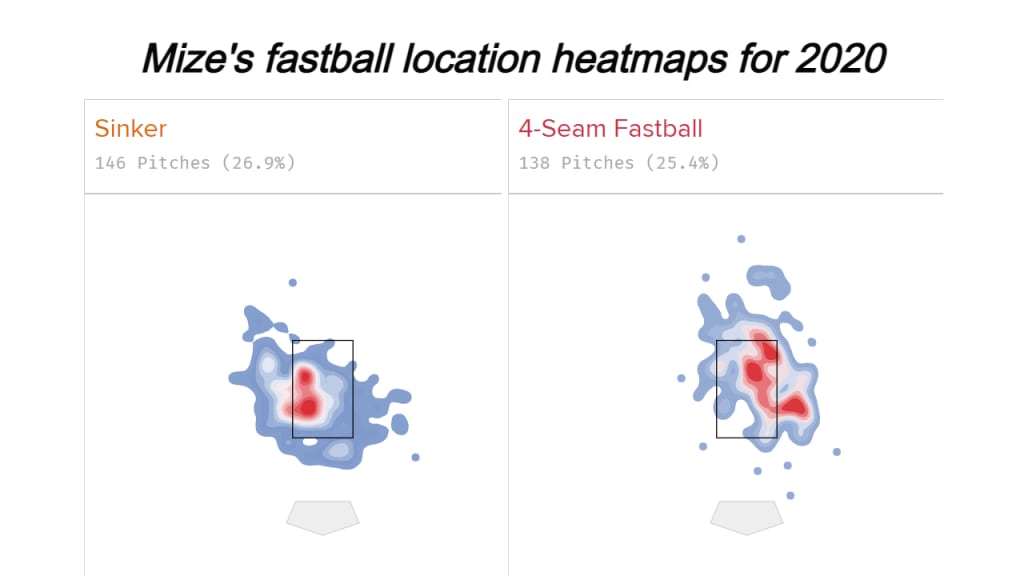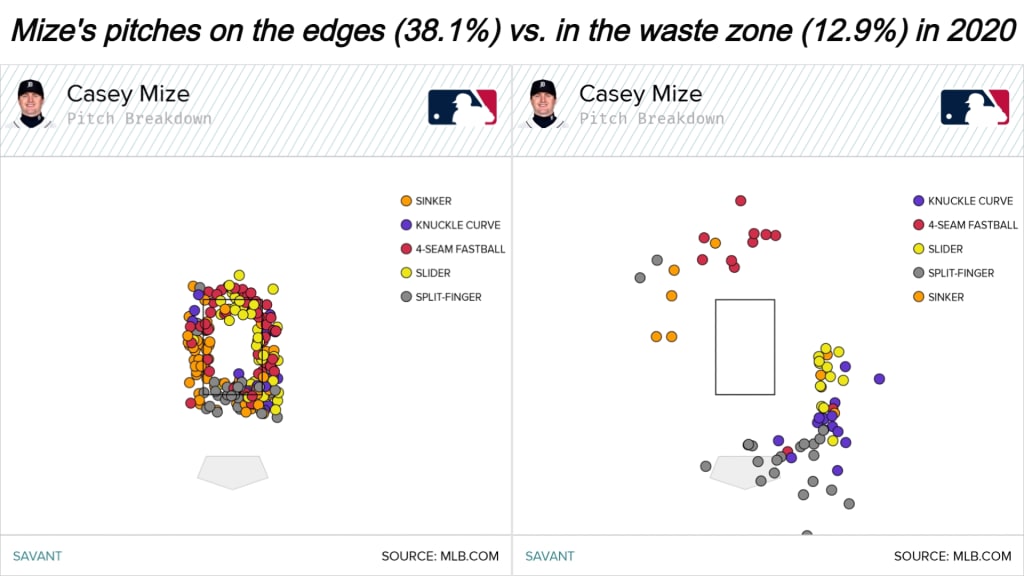Casey Mize should be filthy. He's the No. 11 prospect in baseball on MLB Pipeline's new rankings for 2021, the third-best pitching prospect in the Top 100 and one of the Tigers' unprecedented five prospects in the top 25 overall.
So why was his big league debut in 2020 so underwhelming? Mize had a 6.99 ERA in his seven starts, and it wasn't bad luck. He got knocked around.
Here's the good news: Mize's stuff is worth betting on. He just needs to make a few adjustments. Here's how Mize can become an ace for the Tigers in 2021 and beyond.
1) Unleash the splitter
Mize's splitter is his best pitch. It's an absolutely nasty pitch. We knew it from the scouting reports, and we saw it when he came up to the Majors.
That splitter is rated the best specialty pitch in the Top 100 for a reason. It has elite movement. It drops off the table. Mize's splitter gets 5.3 inches more vertical movement than an average splitter, the second-most drop in MLB.
Splitters with most drop vs. average in 2020
- Tyler Clippard: +6.3 inches
2) Casey Mize: +5.3 inches
3) Héctor Neris: +5.0 inches
4) Erick Fedde: +3.9 inches
5) Nathan Eovaldi: +3.3 inches
Mize got more strikeouts with his splitter, 10, than he did with any other pitch in 2020. But he also got mixed results -- he allowed a .313 batting average against it -- and it wasn't even his most-used secondary pitch. That was his slider (or cutter, as he calls it). Mize threw just under 18% splitters overall (although he did throw them 35% of the time in two-strike counts).
But he knows the underlying stuff is there. As Mize said recently: "I threw some really good ones and yanked a few and sailed a few and a bunch got hit. So a lot of people are wondering, 'This is supposed to be an amazing pitch, what’s up with it?' Well, the thing is, the metrics didn’t change very much on the pitch."
Maybe he could take a page out of Masahiro Tanaka's playbook going forward. Tanaka, whose splitter was his signature, consistently threw it around 25-30% of the time in the Majors.
Mize's splitter even has some similarity to Tanaka's in terms of its velocity and movement profile. In recent seasons, Tanaka's splitter generally sat in the 87 mph range, with a little over 30 inches of drop and a little under 13 inches of horizontal break. In 2020, Mize's splitter averaged 86 mph, 38 inches of drop and 12.5 inches of horizontal break.
The splitter has all the potential to be an elite pitch for Mize. But "unleash the splitter" isn't just "throw more splitters." There's more to it.
2) Pitch vertically
This is a big change Mize could make ... and he even knows it.
Mize spent his debut season pitching horizontally across the strike zone -- as in, attacking the left and right sides of the plate (chiefly with his two-seam and four-seam fastballs but also with his sliders and curves) rather than going up and down in the strike zone.

That's what he should try doing instead. It's what aces like Shane Bieber and Lucas Giolito and Blake Snell and Tyler Glasnow do, and it's a style that fits for Mize. Because his splitter is a vertical pitch. He should be able to get the most out of it if he pairs it with fastballs to attack hitters up and down along the same vertical plane.
And guess what? Mize is already planning to adapt his repertoire toward that approach, as he told FanGraphs' David Laurila in a recent Q&A.
"It’s pretty much a horizontal profile," Mize said of how he pitched in 2020. "We’re starting to take the four-seamer up a little bit to add a little more vertical, because it played so well last year. My splitter is super vertical, and we’re trying to really maximize that."
Emphasizing four-seamers, which he can elevate, should make his down-breaking splitter even more effective, especially because the four-seamer is closer in movement profile to the splitter -- Mize's four-seam fastball averages 10.8 inches of horizontal movement to his splitter's 12.5 inches, meaning they'll look more like each other as they approach the hitter, while his two-seamer gets a lot more running action, averaging 17.3 inches of horizontal break.
But the two-seamer has a function in all this, too, as Mize noted in the Q&A: "to mask the splitter." Mize throws his two-seam fastball with a closer spin axis to his splitter than his four-seamer has -- they both rotate more side-to-side, while his plan for his four-seamer is to have a truer backspin axis ("The axis will tick up when I throw it up in the zone," he said).
Even Mize's slider could benefit from the same type of vertical usage in tandem with his four-seamer, since it's tight like a cutter and doesn't break that much horizontally (it averages 29.1 inches of vertical movement and 1.2 inches of horizontal movement). If Mize can get all of his pitches working together up and down through the zone, with his splitter and slider dropping out from under his fastballs, his repertoire should gain a newfound synergy.
3) Get onto the edges
There is one last improvement Mize needs to make. He's wasting way too many pitches, and he's not making enough pitcher's pitches.
Mize hit the edges of the strike zone at one of the lowest rates of any pitcher in the Majors last year. And his pitches were in the "waste" zone -- far out of the strike zone, where a hitter rarely swings -- at one of the highest frequencies of any pitcher.
Lowest edge % in 2020
Of 166 pitchers with 500+ total pitches thrown
- Phillips Valdez: 36.3%
- Robbie Ray: 37.9%
3-T) Zack Godley: 38.0%
3-T) Kris Bubic: 38.0%
5) Casey Mize: 38.1%
Edges: Within one baseball's width of the strike zone borders
Highest % of pitches in the "waste" zone in 2020
Of 166 pitchers with 500+ total pitches thrown
- Zack Godley: 14.3%
2-T) Michael Lorenzen: 13.8%
2-T) Dylan Cease: 13.8% - Shane Bieber: 13.3%
5) Casey Mize: 12.9%
Waste zone: Extreme out-of-zone pitches

Throwing pitches in the waste zone isn't always bad by itself -- pitchers like Bieber and Glasnow, with sharp curveballs that they use to bury the hitter once they get ahead in the count, often end up there. But for Mize, who got behind in too many counts in 2020, the combination of a low edge percentage and high waste percentage is bad.
To command the strike zone better, he probably needs to get out of the waste zone and onto the edges. His splitter should be devastating, but it has to look like a strike, and keeping the ball around the edges of the zone is what will make it look like a strike. (This is what Tanaka did so well.)
Unleash his splitter, pitch vertically and command the edges of the strike zone -- three easy steps for Mize to turn into an ace in Detroit. OK, maybe not easy. But the foundation is there if he can follow the blueprint other aces have demonstrated.
